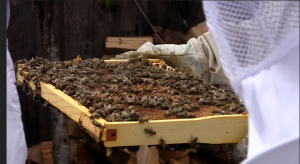
Whether for the value of craftsmanship, the appeal of DIY, or the satisfaction of “homemade” honey, backyard beekeeping is becoming a popular hobby in the Bay Area. Within the San Mateo Beekeeper’s Guild alone, membership has increased from 40 to 250 members in the last five years. “Five or six years ago, you hardly saw a bee in the garden, but because of hobbyists putting bees in the backyard, populations of bees have exploded,” said Richard Baxter, a professional beekeeper located near Redwood City.
Many hobbyists are particularly enthused about the prospect of producing their own natural honey products, Baxter said. Natural means no chemicals – so these hives are nurtured by nature alone. This, in turn, can make bee colonies more susceptible to pests, parasites, and pathogens. But this sort of tough love could be exactly what domesticated bees need.
Bees, simply put, are in trouble. A mysterious phenomenon called colony collapse disorder, or CCD, arose six years ago when a great number of worker bees began mysteriously fleeing their hives. Researchers are still trying to pinpoint the main causes of this disorder, but they suspect that the decline in genetic diversity among commercial bees is an important cause of CCD. The lack of genetic diversity, the theory goes, is likely to have compromised bees’ abilities to cope with toxins, disease, and other external threats. To compensate, some commercial beekeepers use a variety of pesticides and other chemical controls to fight off common diseases and pests.
That’s where the backyard beekeeping comes in. Home keepers’ reluctance to use chemicals on their hives could be cultivating strains of bees that are resistant to mites and diseases, according to Ramesh Sagili, an apiarist at Oregon State University. If such resistant bees were to mate with commercial bees, which pollinate many of the crops big agriculture relies upon, the offspring could possess more robust genes to fight off outside threats. This, in turn, could decrease rates of colony collapse disorder.
Currently, researchers and some beekeepers are working on breeding disease-resistant strains of bees. But selection for these disease-resistant genes might be occurring in backyard beehives naturally right now, though there is no evidence of this yet.
Commercial beekeepers buy their queens from only a few sources of queen producers—an important cause of the genetic diversity loss, according to bee-breeder and geneticist Susan Cobey at UC Davis. It’s an idea she lays out on a chapter of the new book, Honey Bee Colony Health: Challenges and Sustainable Solutions. Because just one queen produces all the brood in a hive, Sagili said, the limited supply of queens is probably causing a genetic bottleneck.
According to research published this past March in the journal PLoS One, hives that were genetically diverse had fewer pathogens and more abundant “good” bacteria, which may help protect hives from disease. Past research has also shown that boosting the genetic diversity of honeybee colonies can enhance fitness and productivity.
In quite a direct way, promoting diversity of the right genes could translate into resistance to disease among bees. If certain disease-resistant genes were to mix into populations of commercial bees, this would both increase genetic diversity and potentially boost defense against pests, pathogens and parasites.
Treatment-free backyard beekeepers refuse to use chemicals to fight pest and disease threats in their hives because they do not want it to taint their honey. That allows natural selection to do its work, weeding out those colonies that can’t fight off the threats, and leaving behind any strain that can develop resistance. If drones from disease-resistant urban colonies mate with queens in commercial hives, “there is a good chance that hobby beekeepers will benefit the gene pool of the bees that we have in respect to mite resistance and other disease resistance,” Sagili said.
The sacrifice is substantial for treatment-free backyard beekeepers, and their wards—some hobbyists have reported up to 80 percent of their hives are lost in a single year. But the trouble they go to now to secure chemical-free honey just might help ensure we’ll all be able to find honey—and pollinated crops—in the future. Research is still underway to understand colony collapse disorder, but for now, the backyard might indeed be a good place to start looking for solutions.
